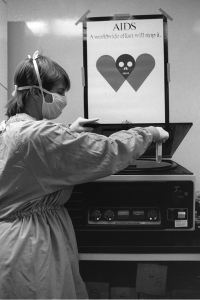Pathogen Detection Laboratory
Thirty years ago, the CNPRC was at the forefront of discovering the role of retroviruses as the causative agent for Acquired Immunodeficiency Syndrome (AIDS). Dr. Murray Gardner, emeritus Professor of Pathology in the UC Davis School of Medicine, often refers to the CNPRC as the “home” of simian AIDS, as early isolates of retroviruses related to human immunodeficiency virus (HIV) were identified in colony animals and studied by researchers here.
The Pathogen Detection Laboratory (PDL) emerged from this early period of retrovirus discovery. In 1985, before there were commercial tests on the market, PDL originated as the AIDS Virus Diagnostic Laboratory (AVDL), founded to develop and provide one of the only testing facilities for the newly discovered public health threat – HIV. The laboratory began life by resurrecting an abandoned research building on the outskirts of campus, sandwiched between the railroad tracks and the cat barn. This new laboratory provided serology and culture results for researchers, blood banks, public health, reference and hospital laboratories, and private physicians across the country.

In 1987 the AIDS Virus Diagnostic Laboratory expanded its services to provide virus testing for nonhuman primates in support of animal models for HIV research. The laboratory played a major role in keeping CNPRC animals healthy by monitoring the eradication of SRV, SIV and Simian T-cell Leukemia Virus (STLV) from the Center’s monkey colonies. Dr. Michael Lairmore, Dean of the UC Davis School of Veterinary Medicine, was one of the lab’s early collaborators on STLV testing. As diagnostic kits for HIV became commercially available and the need for nonhuman primate testing increased, JoAnn Yee, one of the founding staff members from the AIDS Virus Diagnostic Laboratory, began working with Dr. Lerche in the newly formed Simian Retrovirus Reference Laboratory (SRRL). At it’s peak, SRRL processed over 10,000 samples from more than 100 clients for up to half a dozen different agents each year. With growth and expansion of testing for other pathogens identified in nonhuman primates, SRRL underwent a name change to Pathogen Detection Laboratory (PDL).
The legacy of Dr. Lerche’s scientific contributions to PDL remains today. PDL continues to offer testing, but the focus has expanded to providing training, proficiency testing, trouble shooting, reagents, controls, and protocols. The staff’s extensive experience in resolving problem cases is a key factor in their ability to develop new assays and provides a unique service not available in other laboratories.
Learn more about PDL services here.
The Monkey Model for HIV



